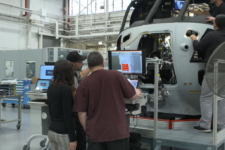 In the third of our ongoing series forecasting key defense issues for 2013, Aerospace Industries Association president Marion Blakey, a member of Breaking Defense’s Board of Contributors, talks about what it will take to preserve the critical defense capabilities in a time of falling budgets.
In the third of our ongoing series forecasting key defense issues for 2013, Aerospace Industries Association president Marion Blakey, a member of Breaking Defense’s Board of Contributors, talks about what it will take to preserve the critical defense capabilities in a time of falling budgets.
If 9/11 brought to an abrupt end Francis Fukuyama’s “End of History” thesis that the spread of liberal democracies and free market capitalism might lead to an era of peace, recent events have provided the United States an even more ominous warning that we must be prepared to address current and emerging long-term threats to our military superiority.
Certainly, countering Iran’s ambition to become a nuclear power and its ongoing efforts to destabilize the Middle East is a real concern. And we must also take seriously the idea that our strategic “Pacific Pivot” may need to be implemented quicker than our military planners initially envisioned. This fall’s saber rattling between China and Japan over a set of contested tiny islands in the South China Sea and East China Sea serve as a sobering reminder that America could well find itself involved in a war between two great Asian powers in the near future.
Unfortunately, these challenges are occurring at a time when the U.S. defense budget is being significantly squeezed by tremendous fiscal pressures. And we know from past eras of defense budget retrenchment that investments in new equipment and research and development of the new systems and capabilities needed to maintain America’s vital technological edge are often first on the chopping block.
There is a corollary concern for national defense involving the scientists, engineers and technicians whose innovation we count on to ensure our nation remains second to none. AIA has documented how mandatory sequestration budget cuts will put at risk 2.14 million jobs across the economy. We have a real concern that once pink slips come to valuable defense workers, we may lose their talents and skills for good.
James Tabbi, the President and CEO of RAF Tabtronics, a Piffard, NY business that designs and manufactures advanced electromagnetic technologies, is emblematic of a defense supply chain company leader who is already feeling the impact of sequestration. “We’ve seen our customers already start pulling back and just be hesitant to cut purchase orders,” he states. “We’ve already seen jobs shrink in our company. Whenever you lose talented people, you lose capability that you may not be able to get back in a month, or two months, or a few years down the road. There’s always the risk of that especially in a small company. Any cutbacks we have to make are very serious.”
In addition to the danger of budget cuts, longstanding demographic trends have the potential to exacerbate the aerospace and defense brain drain we are facing that will be extremely difficult for the Pentagon to manage. For example, the quarter of the Defense Department workforce that the U.S. Government Accountability Office identified back in 2008 as being eligible to retire by 2012 may have hung onto their jobs because of what the recession did to their retirement accounts, but they won’t hang on forever. And what of the young cohort we expect to replace these workers?
A number of factors are leading students away from considering defense-oriented careers. A report released this October by the National Academy of Sciences (NAS) laid it on the line. While “a workforce with robust STEM capabilities is critical to sustaining U.S. preeminence,” wrote the authors, “Today, the STEM activities of the DOD are a small and diminishing part of the nation’s overall science and engineering enterprise.” The report focused not only on the lack of DOD STEM programs, but on the difficulty of hiring foreign nationals for defense work because they cannot obtain security clearances. Yet they constitute more than 50 percent of America’s new graduates in STEM disciplines.
In addition, long-time aerospace giant Norman Augustine, who co-chaired the NAS report, pointed out that defense work is becoming less and less attractive to those graduates who are eligible to assist our defense effort because of a poor incentive structure: College graduates recognize the futility of working 20 years on a new weapons project only to have it scrapped before it’s fielded.
Clearly, when the administration and new Congress take a hard look at our national defense needs in the coming year, I hope they will examine what it will take to ensure, as the NAS report details, “that STEM competencies in all potentially critical, emerging topical areas are maintained at least at a basic level within the (Defense) department and its industrial bases.”
It seems like ages ago, but still one of the best political advertisements in recent memory was Hillary Clinton’s ad about the 3:00 am call to the White House. Although everyone prays that such calls are few and far between, are we really doing what’s necessary to ensure that any American President has both the military equipment and human capital he or she will need when the next 3:00 am phone call comes? I certainly worry about this a great deal. It’s what keeps me up in the middle of the night.
Global interest in Iranian drones unlikely to wane despite failed Israel attack
Though virtually none of the estimated 170 drones Iran launched at Israel got through defenses, analysts told Breaking Defense there’s an eager market globally for Tehran’s relatively cheap, normally effective UAVs.


























